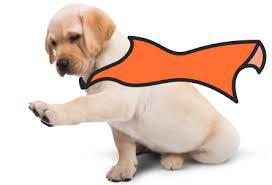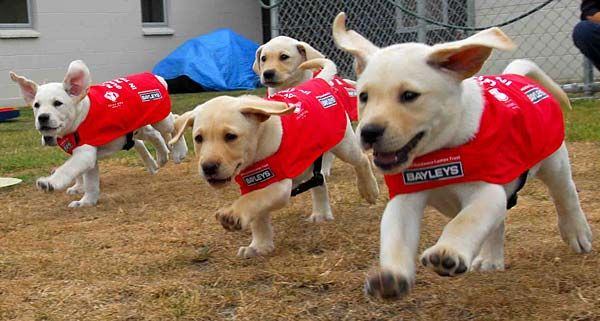It is difficult to be blind or visually impaired in the modern world: there is an opportunity to fall under the wheels of public transport, walk past the desired building, fall into an open hatch or stumble on the steps of a staircase, and finally become a victim of robbers. Guide dogs are called to help people with serious vision problems – companions and faithful friends of those who are deprived of the opportunity to fully see the world around them. Guide – this is how a guide dog is called differently in the field of dog handlers. 
Selection criteria for guide dogs
A guide dog for the blind is an animal specially trained by dog handlers that accompanies a blind person along a predetermined route, and also helps him adapt to life in modern society. Given the complexity of the work of guide dogs, it is not surprising that not every animal will be able to come up to help the blind. The best guide dogs are those that meet the following requirements:
- The average height at the withers of the animal should range from 65-70 cm;
- Excellent health of the animal (after all, it will be difficult for a blind person to take care of a dog at the time of its illness);
- The stable psyche of the dog (the animal must adequately respond to strangers, calmly relate to city noises, be indifferent to cats);
- The dog’s lack of indulgence in instincts (a guide dog should not, for example, abandoning its owner, run after an individual of the opposite gender or after a cat);
- An active, cheerful, and gentle disposition is a prerequisite for a guide dog.
But the breed of the dog, oddly enough, does not really matter. You can even train a real guide from a mongrel. The main thing is that the dog meets all the requirements. Although most often Labrador Retrievers are chosen as guides.
Who is eligible for a guide dog
It would be nice for every visually impaired or even blind person to have an assistant – a guide dog. But there are some requirements for the potential owner of such a dog:
- Age over 18;
- Russian citizenship;
- Good or satisfactory condition of the motor system (all guide dogs in Russia are animals of considerable size, a weakened person may not be able to keep a small dog on a leash);
- Availability of a certificate of visual disability.
Besides, the future owner of a guide dog needs to provide the animal with high-quality care (organization of a berth, daily walks, feeding, bathing, vaccinations, preventive measures against parasites, etc.).
Methods for preparing guide dogs for work
Now let’s find out how the training of a guide dog goes. To serve a visually impaired person, healthy dogs are selected that meet all the requirements of a guide (theoretically, dog handlers can train their own dog for a blind person, but it is preferable if the choice of an animal is for specialists). Special organizations are engaged in the training of guide dogs.
During the first year of life, dogs destined to become guides undergo a course of obedience (training in basic commands “to me”, “next to”, “sit”, “lie down”, “stand”, “no”, “place”, “aport ” etc.). A little later, for six months, the animals undergo a specialized course in driving a blind person (the main purpose of such training is the dog memorizing certain city routes, for example, “home-clinic-home” or home-shop-home “).
Training takes place not only at the training base of the canine center, dogs are regularly taken to the city, where there is an opportunity to meet big tops of people, cars and other vehicles, other animals, hear the city noise (sirens of special vehicles, construction noise, loud music, etc.) ). After training, each dog preparing for the mission to become a guide for the blind passes an exam, demonstrating excellent knowledge of commands and the ability to navigate in the conditions of a city street (climbing stairs, crossing roads at traffic lights, warning a person about an obstacle on the way, etc.).
Then the trained dog is handed over to its potential owner – a person with vision problems. Within 2 weeks, under the supervision of dog handlers, a blind citizen communicates with a dog, learns to control an animal with the help of commands, and learns the rules of keeping his new pet.
The best guide dogs
As mentioned above, theoretically, even a mongrel dog can become excellent guide assistants for the blind. But the most popular guides are representatives of such breeds:
- Labrador and Golden Retriever (both in Russia and in Europe they rely on these dogs);
- German and Scottish Shepherd Dogs;
- Giant Schnauzer;
- Doberman;
- Rottweiler;
- Royal poodle;
- German boxer;
- Australian Shepherd (Aussie).
Recognition of guide dogs
Given the complexity of the work of guide dogs, it is not surprising that grateful people decided to perpetuate the memory of these hard workers. The monument to the unknown guide dog was erected at the end of the 20th century in the capital of Germany in the oldest Berlin Zoo.
The price of an assistant for the blind
The guide dog helps his blind owner to cross the busy streets, along which the traffic rushes back and forth, and to cross the road at the green light of the traffic light. Such an animal can warn its owner about obstacles on footpaths in the form of pits, bumps, poles, fences, accompany a person during a trip (in any type of transport). Besides, the guide is also a true friend for a blind person. Unsurprisingly, many are wondering how much a guide dog costs?
Organizations for the training of assistance dogs do not demand a penny for trained animals with visual impairments. Guide dogs are donated to citizens of the Russian Federation free of charge under a charitable donation agreement. But it will not work to get an assistant dog on the day of contacting the dog training center for the training of guide dogs. Sometimes blind people have to wait 12 months or more for the dog to be provided.
Some citizens apply for the purchase of a guide to canine companies, which provide a service for training guide dogs for a fee.
